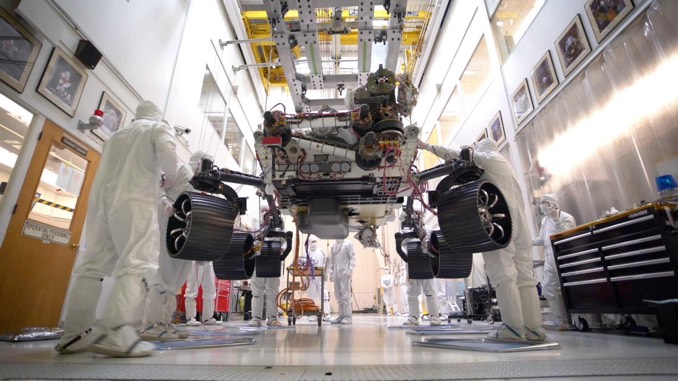This time-lapse video, taken on Oct. 8, 2019, at NASA’s Jet Propulsion Laboratory in Pasadena, California, captures the first time NASA’s Mars 2020 rover has carried its full weight on its legs and wheels.
“After years of design, analysis and testing, it is fantastic to see the rover on her wheels for the first time,” said Ben Riggs, a mechanical systems engineer working on Mars 2020 at JPL. “The whole team looks forward to seeing her in the same configuration on Mars in the not too distant future.”
The rover’s legs (the black tubing visible above the wheels) are composed of titanium, while the wheels are made of aluminium. Measuring 20.7 inches (52.5 centimetres) in diameter and machined with traction-providing cleats, or grousers, the wheels are engineering models that will be replaced with flight models next year. Every wheel has its own motor. The two front and two rear wheels also have individual steering motors that enable the vehicle to turn a full 360 degrees in place.
When driving over uneven terrain, the rover’s “rocker-bogie” suspension system – called that because of its multiple pivot points and struts – maintains a relatively constant weight on each wheel for stability. Rover drivers avoid terrain that would cause the vehicle to tilt more than 30 degrees, but even so, the rover can handle a 45-degree tilt in any direction without tipping over. It can also roll over obstacles and through depressions the size of its wheels.

The Mars 2020 rover was photographed in the Simulator Building at JPL, where it underwent weeks of testing, including an extensive evaluation of how its instruments, systems and subsystems operate in the frigid, near-vacuum environment it will face on Mars.
JPL is building and will manage operations of the Mars 2020 rover for NASA. The rover will launch on a United Launch Alliance Atlas V rocket in July 2020 from Space Launch Complex 41 at Cape Canaveral Air Force Station. NASA’s Launch Services Program, based at the agency’s Kennedy Space Center in Florida, is responsible for launch management.
When the rover lands at Jezero Crater on Feb. 18, 2021, it will be the first spacecraft in the history of planetary exploration with the ability to accurately retarget its point of touchdown during the landing sequence.



